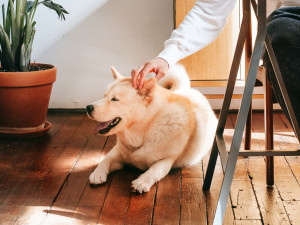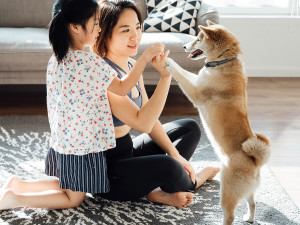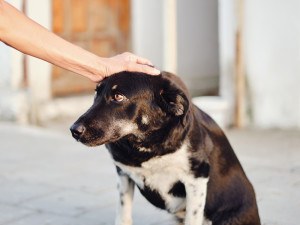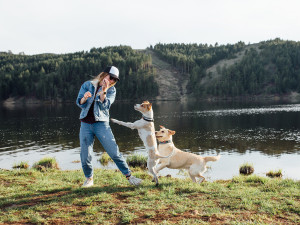Can I Pet Your Dog?
Consent isn’t just for humans. Here’s how to respond when the answer isn’t so simple.
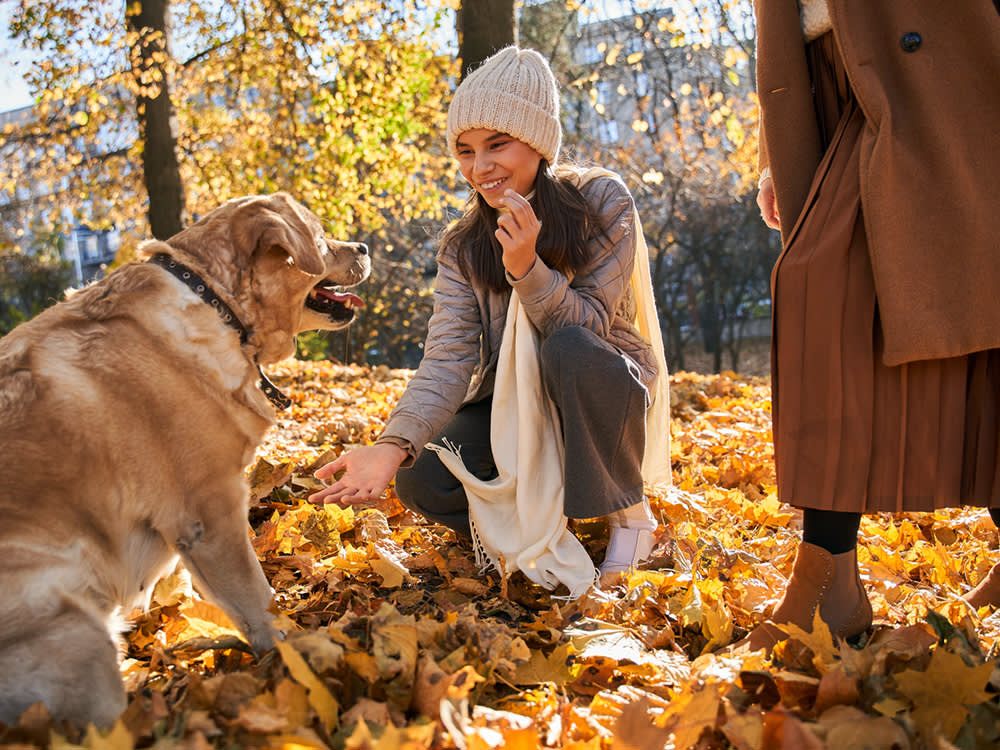
Share Article
As kids, we were taught to ask permission before petting a dog with some variation of “May I please meet your dog?” As adults, we have T-shirts and hats that say, “Tell your dog I said ‘hi.’” But when did we start thinking it was OK to excitedly approach a dog with a big ol’ pet on the head, sans warning?
Do we, as humans, especially after years of social distancing, love a non-consensual pat on the head (seriously, who would do that?) or hug? No. We like to be asked. And so do dog parents who are out in public with their pups.
Read Between the Lines
This simple question has the potential to avoid unpleasant interactions, but only if kids (and adults) are taught how to interpret the possible answers, especially those that are nuanced. The answer might be a simple “Yes.” It could also be a straightforward “No“ for any number of reasons: It’s not safe to pet the dog, the dog will feel uncomfortable if the child attempts to interact, or even that someone is on a tight schedule and doesn’t have time for a meet-and-greet. The person may also seem hesitant but not actually say “No” or give an answer that conveys serious concern.
The clear “Yes” answers are easy to figure out. It’s common for people to reply to a request to meet a dog with some variant of “Sure, she loves people!” “He would love that!” or “Absolutely; thanks for asking!” In that case, there is a good chance that the person expects a positive interaction between a person and a dog. They might be wrong, but there’s no sense of worry or concern being expressed, which is encouraging, and it makes sense for people to approach the dog.
Similarly, a definite “No” from the person is also clear. If a person declines the request, people should respect that and not approach the dog. Common ways that people prevent an interaction are by saying, “I’m sorry, but people make her nervous,” “She’s too shy; it will upset her,” or “I think maybe no, because everything scares her.” They might even say, “No, because she’ll try to bite you.” People who answer in this general way know that the dog can’t handle it and that it would be a mistake to let someone meet her.

Unfortunately, there are two general categories of answers that can be ambiguous, and too few children have been taught to understand them. The first set of such answers is generally positive with mild reservations. These usually indicate that the people are not concerned about their dog being aggressive, but they feel embarrassed about some aspect of their dog. These replies are along the lines of, “OK, but she’s very excitable,” or “Yes, but she may jump on you.”
Sometimes, people just offer a warning that is not behavioral, such as “If you don’t mind getting a lot of fur on you!” In most cases, these responses are not deal breakers. If the person expresses that their dog is unruly or shedding, it’s OK to answer, “I don’t mind dog hair,” or “I don’t think jumping up will put a dark blot on her character!” Just consider whether the dog is not so powerful or out of control that someone could get knocked over. This requires a judgment call, and the most conservative approach is to choose not to meet dogs after such replies. At the very least, proceed with caution.
Another set of answers can be more worrisome, and people need to learn that they should not pet a dog if the dog’s parent says things along the lines of, “That would probably be OK,” or “Well, she’s shy, but we can see how she does,” or “If she’ll let you. I’m not sure because sometimes she can’t handle it.” All of these replies show that a person is in the hope-and-fear zone. (“I hope it will be OK, but I fear that it will not be.”) There is a great risk that the interaction could not end well for the person or the dog.
Good Rules of Thumb
Kids, who can often scare dogs, should be taught that the correct action upon hearing such remarks is not to approach the dog. A simple, “Oh, that’s OK. I wouldn’t want to upset her, but thanks anyway,” is a good phrase to use in those situations.
There are endless possible answers when a person asks, “May I please meet your dog?” The “Yes” and the “No” replies are easy to understand. The former tells you it’s likely to be a positive interaction and the latter lets you know that the person knows the dog can’t handle it and has clearly said so. It’s those intermediate answers that require more careful interpretation. If the answer gives any hint that it might not go well or might distress the dog, it’s best to decline.
Of course, all of this general advice assumes that people have the right read on their dog, and that is not always the case. They may think the dog loves all people, even when the dog’s body language reveals that they are terrified and wants someone to go away. That’s why it’s still important for passersby to learn how to tell that a dog is behaving in a fearful and/or threatening way.
Dog parents’ responses to a request to meet a dog are only one stream of information we can use to decide whether to approach a dog. Still, there’s often a lot of truth in what they say, which is why we should evaluate those responses and act accordingly.

Karen B. London, PhD, CAAB, CPDT-KA
Karen B. London is a certified applied animal behaviorist (CAAB) and certified professional dog trainer (CPDT) who specializes in working with dogs with serious behavioral issues, including aggression. She has written for a variety of magazines including The Bark, Clean Run, and the APDT Chronicle of the Dog, and has published in scientific journals including Behavioral Ecology and Sociobiology, Ethology, Ecology, and Evolution, the Journal of Insect Behavior, and Insectes Sociaux. She is the author of seven books about dog training and canine behavior, including the forthcoming My Dog's Mystery Adventure: And Other Stories From a Canine Behaviorist and Dog Trainer.
Related articles
![mom and daughter playing with puppy]()
How to Introduce Your New Dog to Your Kids
They’ll always remember their first childhood pet—this intro is just the beginning.
![Dog that looks unhappy being patted on the head by someone's hand while sitting on pavement outside]()
Uh, Why Doesn’t My Dog Like Getting Pet?
“No touch-y!”
How to Train a Dog Not to Jump
Kinship Collective dog trainer Robert Haussmann’s pro tips for getting a hyped-up dog to chill out.
